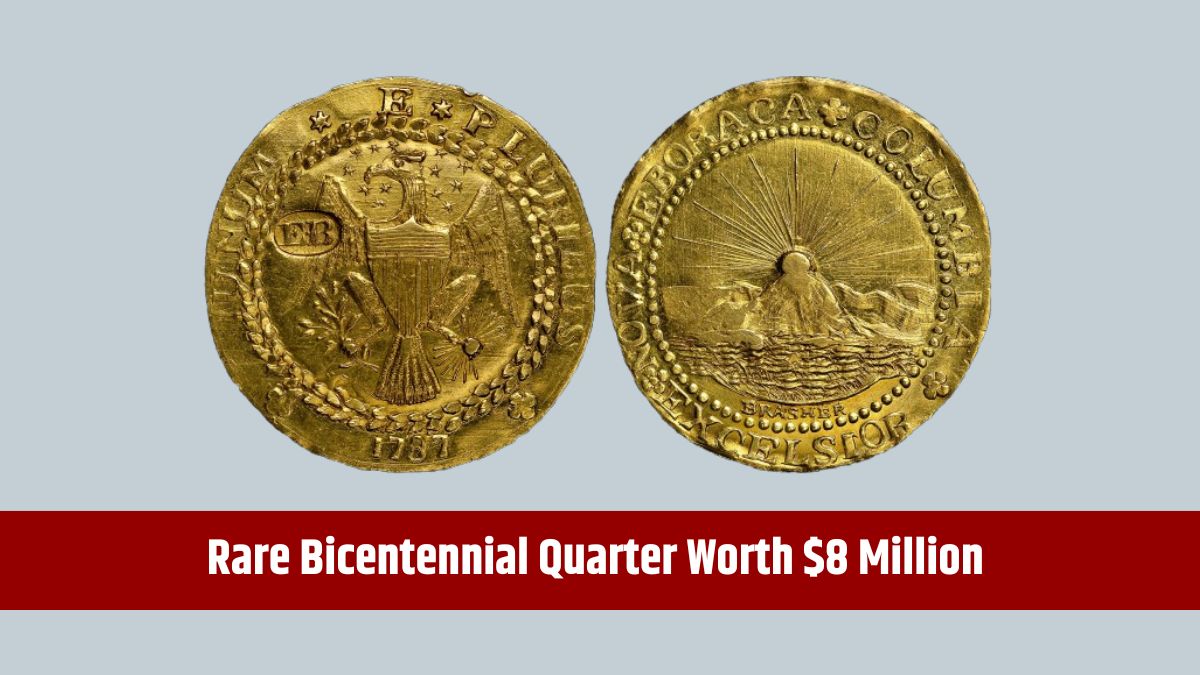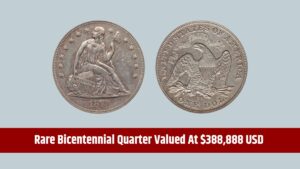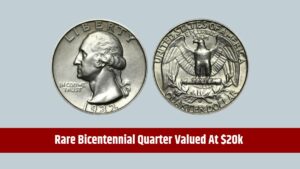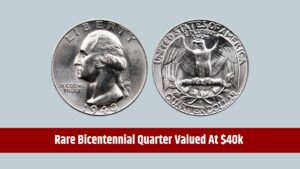Coin collecting is a journey through history, filled with remarkable finds and treasures, each with its own story and value. Among these prized coins, the Bicentennial Quarter shines, valued for both its historical significance and rarity. This article examines this unique quarter alongside six other exceptional coins valued at over $30 million USD, uncovering their allure and remarkable worth in the world of numismatics.
Bicentennial Quarter
Released in 1976 to mark 200 years of American independence, the Bicentennial Quarter was initially intended to be a special commemorative coin. Although most are only worth face value, a rare variant struck in 40% silver with a unique mint mark can be worth nearly $1 million. Collectors treasure this variant not only for its limited production but also for its unique design. It features a drummer boy and a torch encircled by 13 stars, representing the original American colonies. These qualities make the Bicentennial Quarter a sought-after piece among collectors.
| Feature | Details |
|---|---|
| Year of Release | 1976 |
| Estimated Value | Nearly $1 million USD |
| Design | Drummer boy, torch, and 13 stars |
| Significance | Commemorates U.S. bicentennial, unique silver variant |
Flowing Hair Silver/Copper
The Flowing Hair Silver/Copper Dollar, minted in 1794 and 1795, is among the first dollar coins issued by the United States government. Its value, over $30 million, reflects its historical importance as a symbol of America’s early monetary system. Featuring Lady Liberty on one side and an eagle on the reverse, this coin embodies the ideals of the newly established nation. With only a few known specimens, the Flowing Hair Dollar is one of the most coveted pieces in numismatics.
| Feature | Details |
|---|---|
| Year of Minting | 1794–1795 |
| Estimated Value | Over $30 million USD |
| Design | Lady Liberty and eagle |
| Significance | One of the first U.S. federal dollar coins |
Double Eagle
Valued at over $30 million, the 1933 Double Eagle is famous for both its beauty and its complex history. Originally minted as a $20 gold coin, it depicts Lady Liberty striding forward and an eagle in flight. However, due to the Gold Reserve Act of 1934, nearly all of these coins were melted down during the Great Depression. Only a few survived, sparking intense legal battles over ownership. Today, its scarcity and the intrigue surrounding its history make it one of the most desirable coins among collectors.
| Feature | Details |
|---|---|
| Year of Minting | 1933 |
| Estimated Value | Over $30 million USD |
| Design | Lady Liberty and eagle in flight |
| Significance | Scarcity from 1934 Gold Reserve Act |
Brasher Doubloon
The Brasher Doubloon, minted in 1787 by goldsmith Ephraim Brasher, is valued at over $30 million. As America’s first gold coin, its significance predates the establishment of the U.S. Mint. Brasher’s desire to mint his own coins led to the creation of this unique piece, which features an eagle with a shield and the motto “E PLURIBUS UNUM.” This coin’s rarity, combined with its role as a symbol of early American independence, makes it invaluable to collectors.
| Feature | Details |
|---|---|
| Year of Minting | 1787 |
| Estimated Value | Over $30 million USD |
| Design | Eagle with shield, “E PLURIBUS UNUM” |
| Significance | First American gold coin, predates U.S. Mint |
Saint-Gaudens Double
The Saint-Gaudens Double Eagle, minted in 1907, is valued at over $30 million and recognized as a masterpiece of American coinage. President Theodore Roosevelt commissioned the design by Augustus Saint-Gaudens, resulting in a high-relief coin featuring Liberty and an eagle in flight. Its exquisite design and intricate artwork make it one of the most beautiful coins ever produced by the U.S. Mint, and it remains highly prized by collectors for its artistic value.
| Feature | Details |
|---|---|
| Year of Minting | 1907 |
| Estimated Value | Over $30 million USD |
| Design | Lady Liberty and eagle in flight |
| Significance | Commissioned by Theodore Roosevelt, artistic masterpiece |
Liberty Head Nickel
The 1913 Liberty Head Nickel, valued at over $30 million, stands out due to its unintentional creation. Only five known specimens exist, making it exceptionally rare. Struck in a year when no official nickels were to be minted, this coin features Liberty’s head on one side and a Roman numeral “V” surrounded by stars on the other. Its accidental production and extreme rarity make it one of the most valuable coins in U.S. numismatics.
| Feature | Details |
|---|---|
| Year of Minting | 1913 |
| Estimated Value | Over $30 million USD |
| Design | Liberty Head with Roman numeral “V” |
| Significance | Unauthorized minting, only five known copies |
Edward III Florin
The Edward III Florin, minted in 1343, is a medieval English gold coin with a value exceeding $30 million. Its historical significance as one of the earliest gold coins minted in England, combined with its rarity, makes it highly desirable. Featuring the royal seal of King Edward III, this coin represents a remarkable piece of medieval coinage and is prized for its link to England’s royal and economic history.
| Feature | Details |
|---|---|
| Year of Minting | 1343 |
| Estimated Value | Over $30 million USD |
| Design | Royal seal of King Edward III |
| Significance | Early English gold coin, highly rare and historic |
These coins are more than just currency; they are artifacts of historical and artistic significance. Each one represents a unique chapter in the world’s history, from medieval England to the early days of the United States. For collectors, these coins embody the highest achievements of numismatic art and historical preservation.
FAQs
Why is the Bicentennial Quarter valuable?
The rare silver variant with a special mint mark can be worth nearly $1 million.
What makes the 1933 Double Eagle so rare?
Most were melted due to the Gold Reserve Act, with few surviving examples.
How many 1913 Liberty Head Nickels exist?
Only five are known, making it extremely rare.
What is special about the Brasher Doubloon?
It is considered America’s first gold coin, minted before the U.S. Mint.
Why is the Edward III Florin so valuable?
Its rarity and status as an early English gold coin contribute to its value.









